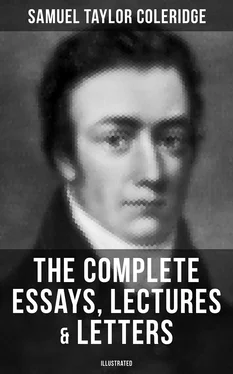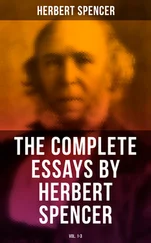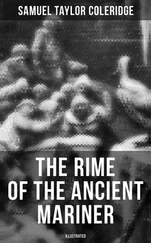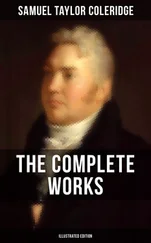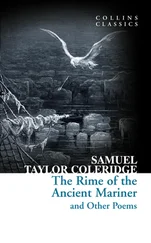The other position, which not only claims but necessitates the admission of its immediate certainty, equally for the scientific reason of the philosopher as for the common sense of mankind at large, namely, I AM, cannot so properly be entitled a prejudice. It is groundless indeed; but then in the very idea it precludes all ground, and separated from the immediate consciousness loses its whole sense and import. It is groundless; but only because it is itself the ground of all other certainty. Now the apparent contradiction, that the former position, namely, the existence of things without us, which from its nature cannot be immediately certain, should be received as blindly and as independently of all grounds as the existence of our own being, the Transcendental philosopher can solve only by the supposition, that the former is unconsciously involved in the latter; that it is not only coherent but identical, and one and the same thing with our own immediate self consciousness. To demonstrate this identity is the office and object of his philosophy.
If it be said, that this is idealism, let it be remembered that it is only so far idealism, as it is at the same time, and on that very account, the truest and most binding realism. For wherein does the realism of mankind properly consist? In the assertion that there exists a something without them, what, or how, or where they know not, which occasions the objects of their perception? Oh no! This is neither connatural nor universal. It is what a few have taught and learned in the schools, and which the many repeat without asking themselves concerning their own meaning. The realism common to all mankind is far elder and lies infinitely deeper than this hypothetical explanation of the origin of our perceptions, an explanation skimmed from the mere surface of mechanical philosophy. It is the table itself, which the man of common sense believes himself to see, not the phantom of a table, from which he may argumentatively deduce the reality of a table, which he does not see. If to destroy the reality of all, that we actually behold, be idealism, what can be more egregiously so, than the system of modern metaphysics, which banishes us to a land of shadows, surrounds us with apparitions, and distinguishes truth from illusion only by the majority of those who dream the same dream? “I asserted that the world was mad,” exclaimed poor Lee, “and the world said, that I was mad, and confound them, they outvoted me.”
It is to the true and original realism, that I would direct the attention. This believes and requires neither more nor less, than the object which it beholds or presents to itself, is the real and very object. In this sense, however much we may strive against it, we are all collectively born idealists, and therefore and only therefore are we at the same time realists. But of this the philosophers of the schools know nothing, or despise the faith as the prejudice of the ignorant vulgar, because they live and move in a crowd of phrases and notions from which human nature has long ago vanished. Oh, ye that reverence yourselves, and walk humbly with the divinity in your own hearts, ye are worthy of a better philosophy! Let the dead bury the dead, but do you preserve your human nature, the depth of which was never yet fathomed by a philosophy made up of notions and mere logical entities.
In the third treatise of my Logosophia, announced at the end of this volume, I shall give (Deo volente) the demonstrations and constructions of the Dynamic Philosophy scientifically arranged. It is, according to my conviction, no other than the system of Pythagoras and of Plato revived and purified from impure mixtures. Doctrina per tot manus tradita tandem in vappam desiit! The science of arithmetic furnishes instances, that a rule may be useful in practical application, and for the particular purpose may be sufficiently authenticated by the result, before it has itself been fully demonstrated. It is enough, if only it be rendered intelligible. This will, I trust, have been effected in the following Theses for those of my readers, who are willing to accompany me through the following chapter, in which the results will be applied to the deduction of the Imagination, and with it the principles of production and of genial criticism in the fine arts.
THESIS I
Truth is correlative to being. Knowledge without a correspondent reality is no knowledge; if we know, there must be somewhat known by us. To know is in its very essence a verb active.
THESIS II
All truth is either mediate, that is, derived from some other truth or truths; or immediate and original. The latter is absolute, and its formula A. A.; the former is of dependent or conditional certainty, and represented in the formula B. A. The certainty, which adheres in A, is attributable to B.
SCHOLIUM. A chain without a staple, from which all the links derived their stability, or a series without a first, has been not inaptly allegorized, as a string of blind men, each holding the skirt of the man before him, reaching far out of sight, but all moving without the least deviation in one straight line. It would be naturally taken for granted, that there was a guide at the head of the file: what if it were answered, No! Sir, the men are without number, and infinite blindness supplies the place of sight?
Equally inconceivable is a cycle of equal truths without a common and central principle, which prescribes to each its proper sphere in the system of science. That the absurdity does not so immediately strike us, that it does not seem equally unimaginable, is owing to a surreptitious act of the imagination, which, instinctively and without our noticing the same, not only fills up the intervening spaces, and contemplates the cycle (of B. C. D. E. F. etc.) as a continuous circle (A.) giving to all collectively the unity of their common orbit; but likewise supplies, by a sort of subintelligitur, the one central power, which renders the movement harmonious and cyclical.
THESIS III
We are to seek therefore for some absolute truth capable of communicating to other positions a certainty, which it has not itself borrowed; a truth self-grounded, unconditional and known by its own light. In short, we have to find a somewhat which is, simply because it is. In order to be such, it must be one which is its own predicate, so far at least that all other nominal predicates must be modes and repetitions of itself. Its existence too must be such, as to preclude the possibility of requiring a cause or antecedent without an absurdity.
THESIS IV
That there can be but one such principle, may be proved a priori; for were there two or more, each must refer to some other, by which its equality is affirmed; consequently neither would be self-established, as the hypothesis demands. And a posteriori, it will be proved by the principle itself when it is discovered, as involving universal antecedence in its very conception.
SCHOLIUM. If we affirm of a board that it is blue, the predicate (blue) is accidental, and not implied in the subject, board. If we affirm of a circle that it is equi-radial, the predicate indeed is implied in the definition of the subject; but the existence of the subject itself is contingent, and supposes both a cause and a percipient. The same reasoning will apply to the indefinite number of supposed indemonstrable truths exempted from the profane approach of philosophic investigation by the amiable Beattie, and other less eloquent and not more profound inaugurators of common sense on the throne of philosophy; a fruitless attempt, were it only that it is the twofold function of philosophy to reconcile reason with common sense, and to elevate common sense into reason.
THESIS V
Such a principle cannot be any THING or OBJECT. Each thing is what it is in consequence of some other thing. An infinite, independent thing, is no less a contradiction, than an infinite circle or a sideless triangle. Besides a thing is that, which is capable of being an object which itself is not the sole percipient. But an object is inconceivable without a subject as its antithesis. Omne perceptum percipientem supponit.
Читать дальше
